(1)
St. Johns, FL, USA
(2)
Helen Keller Foundation for Research and Education, International Society of Ocular Trauma, Birmingham, AL, USA
(3)
Consultant and Vitreoretinal Surgeon, Milos Eye Hospital, Belgrade, Serbia
(4)
Consultant and Vitreoretinal Surgeon, Zagórskiego Eye Hospital, Cracow, Poland
13.1 The Contact Lens1
Even if a high-resolution “macula lens” of a wide-angle viewing system2 is used, the plano-concave (“flat”) contact lens provides superior resolution for fine work on the posterior pole (see Fig. 13.1). The field of view is 36° with the contact lens and there is no magnification.3
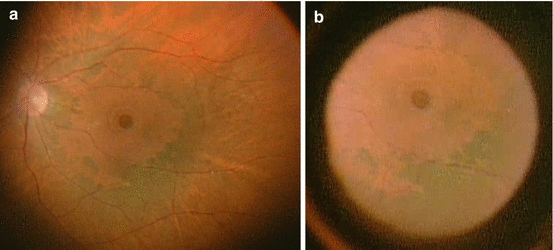

Fig. 13.1
Comparison between the image seen through a high-resolution macula lens and the contact lens. (a) A large field and decent resolution with the BIOM high-resolution macula lens is achieved in this patient who had ICG-staining before removing the ILM for a macular hole. The EMP causes a “negative staining,” mostly in the vicinity of the hole. (b) At the same magnification of the microscope in the same patient, the field is noticeably smaller, but more details are visible when viewed through the plano-concave macular contact lens
It is not advisable, however, to use a contact lens for manipulations outside the posterior pole. Even the “wide-field” contact lens will not provide a field greater than 48°,4 and these actually shrink the image size (0.45× magnification) due to their concave anterior surface. The prism lens (30°) allows work in the periphery, 360° if rotated, but the individual field of view is only 33°.
13.2 Hand Instruments5
One of the benefits of working with intravitreal hand tools is that they have a fixed outer diameter: the distance between their business end to the entry port is irrelevant. This advantage becomes evident when the surgeon wants to cut a membrane in the AC with traditional scissors: the further the fulcrum of the tool from the paracentesis, the wider the wound must be (see Fig. 13.2).


Fig. 13.2
Schematic representation of the use of a fulcrum-type scissors. The distance of the fulcrum’s position (dark circle) from the wound (patterned lines) (the distance of the object to be cut from the wound is also important) determines the length of the incision needed to operate the instrument. The wound is the smallest when the fulcrum itself is at the incision (b). When the fulcrum remains outside the eye (a), the incision must be longer, while the longest incision is required with the fulcrum being in the AC itself (c). This is the most common clinical scenario (because most objects are further away from the point of entry than the length of the blade), demonstrating the advantage of VR microinstruments, where the wound length is the same regardless of how far away the tool (i.e., the object to be cut) is inside the eye (see Fig. 13.3 for the single exception to this rule). The black lines on the right of the image show the required wound length
Vitrectomy hand instruments can be classified into the following categories.
Squeezable tools. It is the squeezing of a handle that initiates the action. Forceps and scissors6 belong to this category.
Non-squeezable tools. The surgeon’s hand manipulates these stationary tools in toto, without the need for the fingers to separately activate parts of them. Blades, needles, spatulas, and pics belong to this category.
Hybrid tools. Either minor finger activation (flute needle) or a one-time manipulation (pushing out retractable tools such as a magnet, laser probe, or scraper) is needed.
This distinction is more important for safety than whether the instrument is sharp or blunt (see below): squeezable tools require more dexterity since their operation demands much more complex maneuvers. The use of such instruments underlines the need for firm wrist support (see Sect. 16.2.1) to avoid inadvertent movements of the instrument’s tip, which would risk injuring the retina.7
There is a paradox regarding the use of sharp vs blunt instruments.8
Q&A
Q
How can a blunt instrument (such as a spatula) be less safe in manipulating epiretinal membranes than a sharp tool (such as scissors)?
A
The answer lies in what was described under Sect. 3.2: control by the surgeon. Separation between two tissues is determined by the strength of two forces: adhesion (attachment of one tissue to another) and cohesion (tensile strength of a single tissue – how easily it tears). If the adhesion is stronger and a blunt tool is used for separation, the tissue tears in the area where its cohesion is the weakest. The surgeon’s control over what happens is rather limited. With the use of a sharp instrument, it is the surgeon who decides where to separate (cut the connection between) the two tissues, perhaps more difficult technically, but certainly more controlled (see Sect. 39.3).
13.2.1 Squeezable Instruments9
13.2.1.1 General Concepts of Working with Squeezable Instruments
How the instrument reacts to the surgeon’s squeezing action differs according to the design of the tool, and the surgeon must understand this so that he can use the instrument in the most optimal way. There are two main design types, depending on what happens upon squeezing the handle.10
The outer shaft forces two metal rods together; the movement of the two (occasionally three) endpieces is identical11 (forceps, most scissors; see Fig. 13.3a).
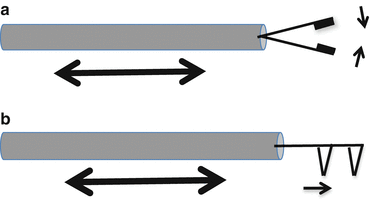
Fig. 13.3
Schematic representation of the workings of squeezable instruments. (a) The outside shaft slides forward (double arrow), forcing the jaws to close (single arrows). In the “fully open” position, the distance between the rods (or blades, depending on the design) exceeds the diameter of the outer shaft. This may cause difficulty when an object is too close to the small wound so that the instrument cannot be fully opened (this is the exception referred to in Fig. 13.2). A classic clinical example is a transcorneal iris suture (McCannel type), where the thread needs to be “fished out” from the AC through a paracentesis: the surgeon is often forced to either use a hook instead of a VR forceps or enlarge the paracentesis. (b) The outside tube slides forward (double arrow), but only the proximal blade moves (singular arrow). With this design, any maneuver is doable, irrespective of wound length or the distance of the target from it (in real life, unlike on the image, the tip of the blade does not reach beyond the imaginary extension of the shaft – otherwise, the tool cannot be inserted through the same size of cannula)
Only one of the endpieces is mobile; the other one is stationary (vertical scissors; see Fig. 13.3b).
13.2.1.2 The Handle
Choose a handle with a short travel route: on Fig. 13.4 “X” should not be more than 2 mm. Increasing the distance results in decreasing stability.
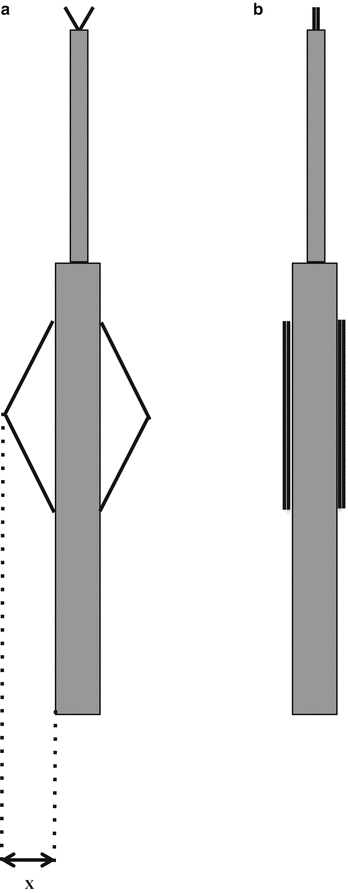
Fig. 13.4
Schematic representation of operating a squeezable instrument. (a) The forceps in the “open” position. The distance each of the surgeon’s fingers must travel to completely close the forceps jaws (b) is indicated by X. The longer X is, the more chance for unintentional movement of the blades to occur, therefore increasing the risk of iatrogenic tissue damage. The way the surgeon can compensate for this is to partially squeeze the handle before actually grabbing the tissue: this reduces the travel distance and thus the risk of undesirable movement of the instrument’s tip (see the text for more details)
The longer the physical distance the surgeon’s fingers must cover to move the forceps jaws from “fully open” to “fully closed,” the more the risk of the jaws making inadvertent movement. This can cause grabbing a membrane too deep (retinal damage) or too superficial (no purchase).12
The resistance to squeezing (i.e., the force needed to operate the instrument; see Sect. 4.1) is also important. Ideally, there is minimal resistance13 – and it must also be a smooth, even one.
A handle that can be operated in a circular fashion (see Fig. 13.5) means that the surgeon is able to rotate the tool and easily maneuver the jaws/blades into the most optimal position.14

Fig. 13.5
Different handle designs on a permanent and a disposable ILM forceps. The permanent one (above) has two semicircles to squeeze; these have minimal resistance and a short travel distance. The only disadvantage is that occasionally the position of the semicircles and the grasping plane of the jaws are not aligned as demanded by the task, forcing the surgeon into holding the forceps in a somewhat awkward position. The disposable forceps (below) eliminates this problem because its circular handle can be squeezed with the same ease, regardless of the position of the jaws. However, the handle has a bit longer travel distance and, more importantly, requires a greater force of squeezing. The undesirable consequence of this is obvious if the forceps needs to be used over extended periods (an ILM that easily tears and needs to be regrasped frequently): the surgeon who had no tremor initially may develop fine shaking toward the end of the peeling
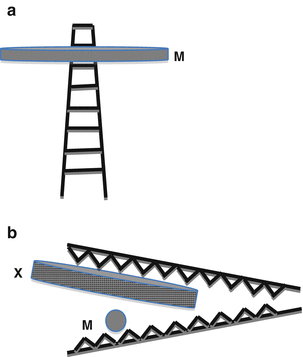
Fig. 13.6
Schematic representation of the serration on the forceps jaws. (a) Current designs have the serration perpendicular to the axis of the forceps (the lower jaw is shown from above). The area of contact with the membrane (M) is small. (b) From a side view, it is even more obvious that only a single tooth is grabbing the membrane (M). If the membrane could be grabbed along the membrane’s long axis (X), the contact area increased greatly. Since this is rarely possible in real life, the serration in this case should be turned by 90°. The ideal serration angle would be at 45°, allowing decent grabbing in all membrane positions
13.2.1.3 Forceps
The surgeon should have a large variety of forceps available for different tasks since their design greatly influences their functionality.15
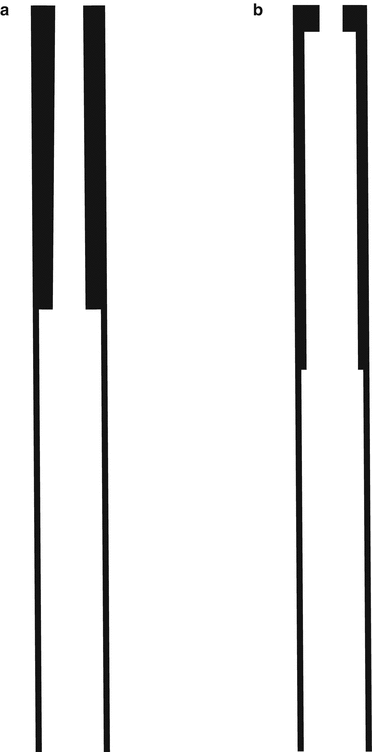
Pointed tips can pick up finer membranes but increase the risk of tissue damage, and they are more prone to tear the grasped membrane since they have a small contact area.
Serration on the jaw surfaces increases the firmness of the grab.
“End-gripping”16 forceps (see Fig. 13.7) come in a wide variety (see also Sect. 32.1.1).
In general, the finer their tip, the better visibility the surgeon has of what exactly the jaws are coming into contact with.
The larger the tip, the easier it is to grab the membrane and the smaller risk of tearing it – but it is more difficult to have decent visual feedback of what exactly is being grabbed.

Fig. 13.7
Schematic representation of standard vs end-gripping forceps designs. Cross-sectional view, forceps in the open position. (a) When the standard type of forceps is closed, the entire surface of the jaws will come into contact: a relatively large area. (b) In the closed position of an end-gripping forceps, only the tips will touch each other; an open space is left behind them, which may increase the visibility of the tip when it is in action
Q&A
Q
Why does a forceps lose its ability to grab fine membranes?
A
Apart from the obvious (damage sustained during sterilization), the nurse may damage the tip intraoperatively as she tries to clean the jaws (remember, she does it in relative darkness and without the use of the microscope; see Chap. 6); the actuating mechanism may get stuck (silicone oil helps), or a piece of the membrane may remain caught between the jaws (see Sect. 32.1.3). The surgeon can also be responsible: serially grabbing thick membranes will destroy the fine-grasp capability of any forceps, not allowing it to grab delicate tissues anymore.
13.2.1.4 Scissors
Scissors with long blades allow the surgeon to see the tip of the blade emerge from under the membrane on its far side. This enhances safety – otherwise, the surgeon can never be absolutely sure that he is not cutting retina underneath the membrane.
Another advantage of the long blade (of a vertical scissors; see below) is that if the surgeon keeps the forceps in the closed position, the blades can be used as a blunt spatula.17
A further disadvantage of the short blades is the membrane’s tendency to be pushed away (distally) as the forceps is actuated; with long blades the risk of the membrane slipping out of the blades is much smaller.
The blade angle has 3 basic variations: vertical, straight, and curved.18 Each has some advantages, but by far the vertical is the most versatile one. It is also the least risky (causing iatrogenic retinal damage) as its sharp tip does not directly point toward the retina.19
In the open position, the vertical scissors can act as a bent needle (see below, Sect. 13.2.3.1). In most cases, with careful maneuvering, even the lower blade with a sharp superior edge can act on the already lifted membrane as a spatula would.20
Stay updated, free articles. Join our Telegram channel

Full access? Get Clinical Tree


